The Taub Center has published its A Picture of the Nation 2025 booklet — this time against the backdrop of an unprecedented security situation, including a prolonged war in Gaza, a Northern front campaign, and war with Iran. The booklet presents an up-to-date and concise overview of the Israeli economy, labor market, welfare services, and the healthcare and education systems, alongside selected data in the areas of early childhood, demography, the environment and health — and includes discussion of the impact of the wars on these areas.
Here are selected findings from the booklet. To read the full publication click here.
A Picture of the Nation was written and edited by Prof. Avi Weiss, President of the Taub Center and Professor of Economics at Bar-Ilan University.
Macro-Economic Trends
A significant long-term shift in the level of defense expenditures
Between 1995 and 2023, defense consumption rose at an average annual rate of 1.8% in constant prices, while GDP grew at an average annual rate of 3.8% over the same period. In real monetary terms, defense consumption increased from NIS 43 billion (in 2015 prices) in 1995 to about NIS 69 billion in 2021, then declined slightly to NIS 65 billion in 2022. As a share of GDP, defense consumption fell from 7.6% in the mid-1990s to about 4.1% in 2022.
As a result of the war, defense expenditures already rose as a share of GDP in 2023, and by 4 percentage points of GDP in 2024; this represents a direct addition of about NIS 100 billion over these two years.
For the decade beginning in 2026, the Nagel Committee recommended increasing the defense budget by NIS 9–NIS 15 billion per year (a total of NIS 133 billion). At this stage, there are no budgetary sources for this increase, and it is likely that the additional spending will be financed by expanding the deficit and raising the debt-to-GDP ratio. Such a move could threaten Israel’s financial stability.
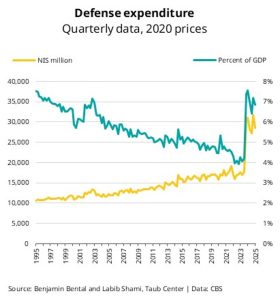
In the first year of the war, Israel’s risk premium spiked, but has declined since October 2024
Judicial reform efforts prior to the war raised the risk premium on Israel’s five-year government bonds from 0.4% at the end of 2022 to about 0.6% on the eve of the war’s outbreak in October 2023. The war pushed the premium up to 1.4%, and to a peak of 1.6% on the eve of Israel’s strike on Iran at the end of October 2024. Since then, there has been a sharp decline in the risk premium, and by early March 2025 it stood at 0.8%. Following this, there was a rising trend, but since the end of the war with Iran, the premium has been falling.
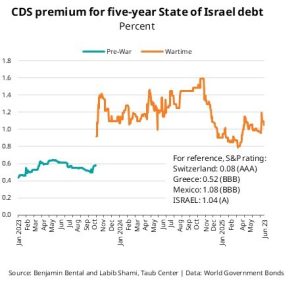
Labor Markets
The rise in average wages in Israel in 2023 was about half the increase in OECD countries
The wage increase in Israel over the past year, while encouraging compared to previous years, is not exceptional in comparison to other high-income countries. Although Israel stood out with unusually high wage growth during the COVID-19 crisis and the recovery that followed, the slowdown in wage growth over the past two years allowed other high-income countries to narrow the gap — though only a few managed to catch up to Israel and surpass it. Over the past year, wage growth in Israel was about half the OECD average, but the cumulative increase since the start of the COVID crisis has been nearly five times the OECD average.
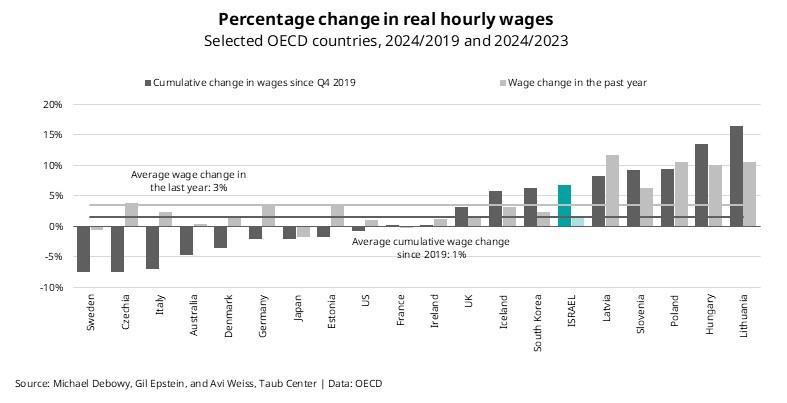
Growth in employment in high-tech services has stalled
In contrast to employment in the high-tech industry, which has remained stable since the beginning of the previous decade, employment in high-tech services grew from about 170,000 workers at the start of the decade to about 290,000 today. This growth was entirely due to the computer programming and consulting sector, which offset the decline in employment in telecommunications services.
The acceleration in employment occurred alongside the significant increase in investment in the high-tech sector during the COVID-19 crisis, and it stalled when the flow of investments declined. The large sums injected into the high-tech sector will allow activity to continue at a high level for several more years, but the drop in investment volume could lead to a decrease in employment in the sector.
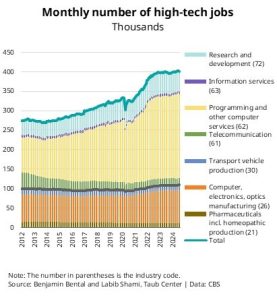
Demography
Israel’s population has passed the 10 million mark
In September 2024, Israel’s population surpassed 10 million. About 9.81 million are citizens, including 2.1 million Arabs and 480,000 classified as “Others.” In addition, over 200,000 foreign workers and international students reside in Israel; the Central Bureau of Statistics began classifying them separately only in 2023.
The growth in the “Others” population — those who are neither Jewish according to halakha nor Arab — is currently the main factor driving the decline in the Jewish share of Israel’s population. Nearly all of the “Others” live in Jewish neighborhoods and lead fully Israeli lives, from kindergarten through military service and integration into the labor market.
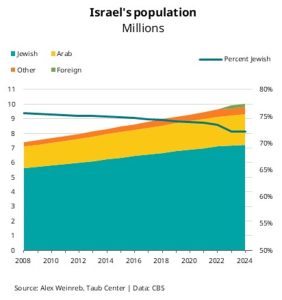
A shift in Israelis’ travel patterns in 2024
Travel to and from Israel typically follows clear seasonal patterns. In June–July, the number of departures exceeds the number of entries, but this usually balances out in August when vacationers return. Similarly, the number of departures also tends to exceed entries around Passover (March–April) and the fall holidays (September), and balances out in May and October.
Two things stood out in 2024. First, in June–July, the net number of Israeli departures reached 250,000 — far more than ever before. The previous peak was 180,000 in 2018. Second, net entries in August and October were significantly lower than in previous years (excluding the COVID period), totaling only 131,000.
The sharp increase in departures in June and July may be attributed to the common practice among families of traveling abroad during the school summer break. In the coming year, we will have a better sense of how many chose to remain abroad.
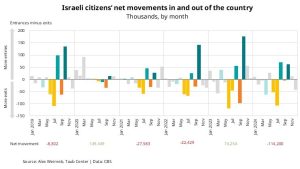
Welfare
A dramatic increase in spending on victims of hostilities
In the decade prior to October 7, 2023, the number of recognized victims of hostilities stood at about 5,000 people per year. Following the massacre and the war, amendments were made to the wording of the law to expand eligibility for assistance under the law and to improve benefit take-up rates. By October 2024, more than 70,000 victims of hostilities had been identified, and by February 2025, 22,666 individuals had received official recognition.
As a result, spending on compensation for victims of hostilities rose sharply — from a monthly average of about NIS 51 million in the five years preceding the war to NIS 261 million in February 2025. Due to these changes and the dramatic expansion of the eligible population under the law, monthly spending on compensation for victims of hostilities reached approximately NIS 480 million at the end of 2023 — nearly ten times the average monthly expenditure on this item in 2022. This amount included grants and initial payments issued by the National Insurance Institute without the need for supporting documents, as part of the expedited recognition process for victims of hostilities.
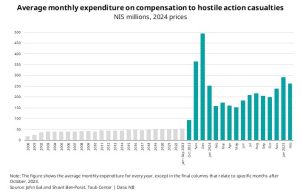
Food insecurity in Israel is higher than the average in high-income countries
Food insecurity in Israel is expanding, especially in recent years. The National Council for Food Security formulated a national framework aimed at reducing its scope. At the same time, the Ministry of Agriculture and Food Security is working on a national food security plan to ensure the long-term food supply for Israeli citizens.
The establishment of the National Authority for the War on Poverty in March 2025 raised concerns about the continued existence of the National Council for Food Security, but it was ultimately decided to keep the Council in place. Nonetheless, sustainable funding is required for its continued operation.
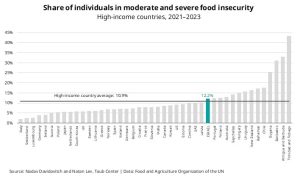
Health
The healthcare system is coping with thousands of hospitalized patients due to the wars
Over the past 20 months, the healthcare system has been dealing with a large number of wounded individuals from the wars on multiple fronts — Gaza, Lebanon, Yemen, and Iran. The highest average daily number of hospitalized patients due to the wars was recorded in October 2023. In both November and December 2023, the daily average of new hospitalizations remained above 100. In October 2024, after nine months with lower daily averages, there was a renewed increase in hospitalizations due to intensified fighting with Hezbollah. In June 2025, during the war with Iran, the average daily number of hospitalized patients was the highest since October 2023.
On October 7 and 8, 2023, 2,061 people were hospitalized in Israel due to Hamas’s surprise attack. This figure is equivalent to 12% of the total number of general hospital beds in the country. During the 12 days of Operation Rising Lion, more than 3,700 people were hospitalized — over 300 per day on average.
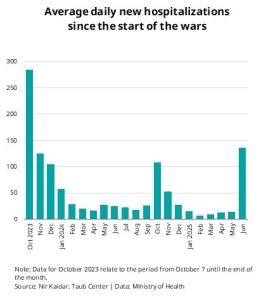
Type 2 diabetes incidence rates among Arabs are expected to rise faster than among Jews
The fastest increase in new cases of type 2 diabetes in the Jewish population is expected to occur between 2025 and 2035, as large age cohorts reach the ages at which incidence rates peak. Between 2028 and 2032, the number of new cases in the 55–64 age group is projected to grow by about 3% per year, after which growth rates will decline to 1%–2% annually. Overall, the average annual growth rate for 2020–2040 is expected to be 1.52%.
In the Arab population, a much higher growth rate is expected. This is due to a combination of a more stable age structure above age 20 and a sharp increase in new cases under age 50. If age-specific incidence rates remain constant, the number of new cases in the Arab population is projected to increase by no less than 2.8% annually through 2028, and by 2.5% annually through 2034.
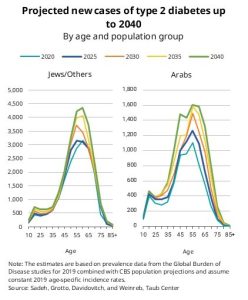
Education
Public spending on higher education in Israel is low compared to the OECD average
In the 2023 budget, public spending on higher education in Israel totaled about NIS 12 billion, or roughly 0.7% of GDP. In 2020, public expenditure per student in Israel stood at $8,526 (in purchasing power parity terms) — significantly lower than the OECD average of $14,039.
Israel’s spending is not only lower than that of most comparable countries, including generous welfare states such as Sweden, Norway, and Denmark, but also lower than in conservative welfare states like France and Germany. Even liberal welfare states such as the United States invest more per student than does Israel.
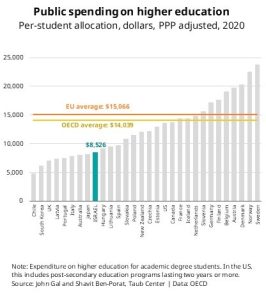
Early Childhood
The closure of educational frameworks at the start of the war exacerbated children’s emotional and behavioral difficulties
A survey conducted by the Taub Center’s Initiative on Early Childhood Development and Inequality among parents of young children during the war points to a clear trend: children whose educational frameworks were closed for more than two weeks experienced more difficulties than those whose frameworks were closed for up to two weeks. In the second and third waves of the survey, there was a marked decline in the level of difficulties, and no significant differences were observed between the groups of children based on the length of the closures.
Children who were out of educational settings for more than two weeks likely experienced more challenges due to instability in their daily routines and the absence of educational and emotional support. However, the improvement in their condition in the second and third waves indicates an ability to adapt — both on the part of the children and their families — and possibly also an ability to find alternative solutions. This suggests that while closing educational settings during emergencies may have an immediate impact on children’s emotional well-being, the effect is not necessarily long-lasting.
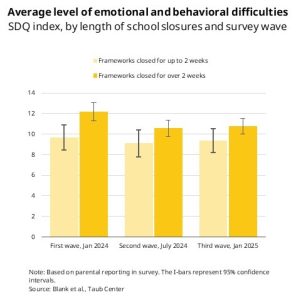
Environment & Health
Israel ranks low on the Environmental Policy Stringency Index
Reducing landfill waste is one of the most important policy tools for lowering greenhouse gas emissions that contribute to global warming. A monitoring report by the Ministry of Environmental Protection points to delays in implementing a significant portion of environmental policy measures.
These delays are reflected in Israel’s low score on the EPS Index, which assesses the degree of implementation of environmental policy, with a focus on emissions reduction and climate change preparedness. Compared to other countries in the Mediterranean Basin, Israel ranks near the bottom — only Turkey scores lower. Countries with higher scores on this index demonstrate better environmental performance.
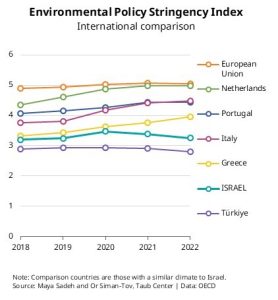
Prof. Avi Weiss, President of the Taub Center and author of the booklet:
“The primary goal of publishing A Picture of the Nation, like all Taub Center publications, is to provide Israeli decisionmakers with the data and professional analyses needed to make informed and sound decisions for the State of Israel across all socioeconomic domains. We aim to do so in a clear and accessible manner, free of political bias and without relying on speculation or preconceived notions. Our hope is that this booklet will assist both policy makers and the general public, and serve as a valuable source of knowledge for all our readers.”
The Taub Center for Social Policy Studies in Israel is an independent, non-partisan socioeconomic research institute. The Center provides decision makers and the public with research and findings on some of the most critical issues facing Israel in the areas of education, health, welfare, labor markets and economic policy in order to impact the decision-making process in Israel and to advance the well-being of all Israelis.
For details, or to arrange an interview, please contact Chen Mashiach, Spokesperson: 054-7602151.
